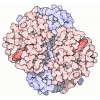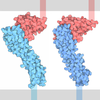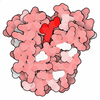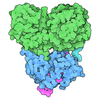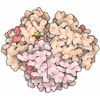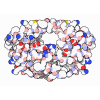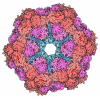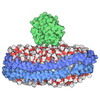[English] 日本語
 Yorodumi
Yorodumi- PDB-4r2g: Crystal Structure of PGT124 Fab bound to HIV-1 JRCSF gp120 core a... -
+ Open data
Open data
- Basic information
Basic information
| Entry | Database: PDB / ID: 4r2g | ||||||||||||
|---|---|---|---|---|---|---|---|---|---|---|---|---|---|
| Title | Crystal Structure of PGT124 Fab bound to HIV-1 JRCSF gp120 core and to CD4 | ||||||||||||
 Components Components |
| ||||||||||||
 Keywords Keywords | IMMUNE SYSTEM / Protein-Protein complex / IgG / Anti-HIV antibodies / gp120 | ||||||||||||
| Function / homology |  Function and homology information Function and homology informationIgD immunoglobulin complex / helper T cell enhancement of adaptive immune response / interleukin-16 binding / interleukin-16 receptor activity / IgA immunoglobulin complex / IgM immunoglobulin complex / response to methamphetamine hydrochloride / IgE immunoglobulin complex / maintenance of protein location in cell / cellular response to ionomycin ...IgD immunoglobulin complex / helper T cell enhancement of adaptive immune response / interleukin-16 binding / interleukin-16 receptor activity / IgA immunoglobulin complex / IgM immunoglobulin complex / response to methamphetamine hydrochloride / IgE immunoglobulin complex / maintenance of protein location in cell / cellular response to ionomycin / T cell selection / MHC class II protein binding / positive regulation of kinase activity / CD22 mediated BCR regulation / interleukin-15-mediated signaling pathway / cellular response to granulocyte macrophage colony-stimulating factor stimulus / positive regulation of monocyte differentiation / Nef Mediated CD4 Down-regulation / Alpha-defensins / IgG immunoglobulin complex / Fc epsilon receptor (FCERI) signaling / regulation of T cell activation / response to vitamin D / extracellular matrix structural constituent / Classical antibody-mediated complement activation / Other interleukin signaling / Initial triggering of complement / T cell receptor complex / immunoglobulin complex / enzyme-linked receptor protein signaling pathway / Dectin-2 family / Translocation of ZAP-70 to Immunological synapse / Phosphorylation of CD3 and TCR zeta chains / positive regulation of protein kinase activity / regulation of calcium ion transport / immunoglobulin mediated immune response / positive regulation of calcium ion transport into cytosol / macrophage differentiation / Generation of second messenger molecules / FCGR activation / immunoglobulin binding / T cell differentiation / Co-inhibition by PD-1 / Role of LAT2/NTAL/LAB on calcium mobilization / Binding and entry of HIV virion / Role of phospholipids in phagocytosis / Scavenging of heme from plasma / antigen binding / coreceptor activity / positive regulation of plasma membrane raft polarization / positive regulation of receptor clustering / positive regulation of T cell proliferation / positive regulation of interleukin-2 production / FCERI mediated Ca+2 mobilization / positive regulation of calcium-mediated signaling / FCGR3A-mediated IL10 synthesis / cell surface receptor protein tyrosine kinase signaling pathway / protein tyrosine kinase binding / Antigen activates B Cell Receptor (BCR) leading to generation of second messengers / Regulation of Complement cascade / host cell endosome membrane / Cell surface interactions at the vascular wall / B cell receptor signaling pathway / FCGR3A-mediated phagocytosis / FCERI mediated MAPK activation / Vpu mediated degradation of CD4 / clathrin-coated endocytic vesicle membrane / calcium-mediated signaling / Regulation of actin dynamics for phagocytic cup formation / FCERI mediated NF-kB activation / positive regulation of protein phosphorylation / Immunoregulatory interactions between a Lymphoid and a non-Lymphoid cell / MHC class II protein complex binding / transmembrane signaling receptor activity / Downstream TCR signaling / response to estradiol / Cargo recognition for clathrin-mediated endocytosis / signaling receptor activity / Clathrin-mediated endocytosis / virus receptor activity / positive regulation of cell growth / response to ethanol / defense response to Gram-negative bacterium / blood microparticle / clathrin-dependent endocytosis of virus by host cell / adaptive immune response / Potential therapeutics for SARS / positive regulation of viral entry into host cell / early endosome / cell surface receptor signaling pathway / positive regulation of ERK1 and ERK2 cascade / positive regulation of canonical NF-kappaB signal transduction / cell adhesion / positive regulation of MAPK cascade / viral protein processing / immune response / membrane raft / endoplasmic reticulum lumen / fusion of virus membrane with host plasma membrane / external side of plasma membrane Similarity search - Function | ||||||||||||
| Biological species |  Human immunodeficiency virus type 1 group M subtype B Human immunodeficiency virus type 1 group M subtype B Homo sapiens (human) Homo sapiens (human) | ||||||||||||
| Method |  X-RAY DIFFRACTION / X-RAY DIFFRACTION /  SYNCHROTRON / SYNCHROTRON /  MOLECULAR REPLACEMENT / Resolution: 3.283 Å MOLECULAR REPLACEMENT / Resolution: 3.283 Å | ||||||||||||
 Authors Authors | Garces, F. / Wilson, I.A. | ||||||||||||
 Citation Citation |  Journal: Cell / Year: 2014 Journal: Cell / Year: 2014Title: Structural evolution of glycan recognition by a family of potent HIV antibodies. Authors: Fernando Garces / Devin Sok / Leopold Kong / Ryan McBride / Helen J Kim / Karen F Saye-Francisco / Jean-Philippe Julien / Yuanzi Hua / Albert Cupo / John P Moore / James C Paulson / Andrew B ...Authors: Fernando Garces / Devin Sok / Leopold Kong / Ryan McBride / Helen J Kim / Karen F Saye-Francisco / Jean-Philippe Julien / Yuanzi Hua / Albert Cupo / John P Moore / James C Paulson / Andrew B Ward / Dennis R Burton / Ian A Wilson /  Abstract: The HIV envelope glycoprotein (Env) is densely covered with self-glycans that should help shield it from recognition by the human immune system. Here, we examine how a particularly potent family of ...The HIV envelope glycoprotein (Env) is densely covered with self-glycans that should help shield it from recognition by the human immune system. Here, we examine how a particularly potent family of broadly neutralizing antibodies (Abs) has evolved common and distinct structural features to counter the glycan shield and interact with both glycan and protein components of HIV Env. The inferred germline antibody already harbors potential binding pockets for a glycan and a short protein segment. Affinity maturation then leads to divergent evolutionary branches that either focus on a single glycan and protein segment (e.g., Ab PGT124) or engage multiple glycans (e.g., Abs PGT121-123). Furthermore, other surrounding glycans are avoided by selecting an appropriate initial antibody shape that prevents steric hindrance. Such molecular recognition lessons are important for engineering proteins that can recognize or accommodate glycans. | ||||||||||||
| History |
|
- Structure visualization
Structure visualization
| Structure viewer | Molecule:  Molmil Molmil Jmol/JSmol Jmol/JSmol |
|---|
- Downloads & links
Downloads & links
- Download
Download
| PDBx/mmCIF format |  4r2g.cif.gz 4r2g.cif.gz | 724.6 KB | Display |  PDBx/mmCIF format PDBx/mmCIF format |
|---|---|---|---|---|
| PDB format |  pdb4r2g.ent.gz pdb4r2g.ent.gz | 601.3 KB | Display |  PDB format PDB format |
| PDBx/mmJSON format |  4r2g.json.gz 4r2g.json.gz | Tree view |  PDBx/mmJSON format PDBx/mmJSON format | |
| Others |  Other downloads Other downloads |
-Validation report
| Summary document |  4r2g_validation.pdf.gz 4r2g_validation.pdf.gz | 1.2 MB | Display |  wwPDB validaton report wwPDB validaton report |
|---|---|---|---|---|
| Full document |  4r2g_full_validation.pdf.gz 4r2g_full_validation.pdf.gz | 1.3 MB | Display | |
| Data in XML |  4r2g_validation.xml.gz 4r2g_validation.xml.gz | 156.4 KB | Display | |
| Data in CIF |  4r2g_validation.cif.gz 4r2g_validation.cif.gz | 199.2 KB | Display | |
| Arichive directory |  https://data.pdbj.org/pub/pdb/validation_reports/r2/4r2g https://data.pdbj.org/pub/pdb/validation_reports/r2/4r2g ftp://data.pdbj.org/pub/pdb/validation_reports/r2/4r2g ftp://data.pdbj.org/pub/pdb/validation_reports/r2/4r2g | HTTPS FTP |
-Related structure data
- Links
Links
- Assembly
Assembly
| Deposited unit | 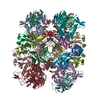
| ||||||||
|---|---|---|---|---|---|---|---|---|---|
| 1 | 
| ||||||||
| 2 | 
| ||||||||
| 3 | 
| ||||||||
| 4 | 
| ||||||||
| Unit cell |
|
- Components
Components
-Protein , 2 types, 8 molecules EOAKFBHL
| #1: Protein | Mass: 34754.543 Da / Num. of mol.: 4 Source method: isolated from a genetically manipulated source Source: (gene. exp.)  Human immunodeficiency virus type 1 group M subtype B Human immunodeficiency virus type 1 group M subtype BStrain: isolate JRCSF / Gene: env / Cell line (production host): 293 FreeStyle / Production host:  Homo sapiens (human) / References: UniProt: P20871 Homo sapiens (human) / References: UniProt: P20871#2: Protein | Mass: 20419.252 Da / Num. of mol.: 4 Source method: isolated from a genetically manipulated source Source: (gene. exp.)  Homo sapiens (human) / Gene: CD4 / Production host: Homo sapiens (human) / Gene: CD4 / Production host:  |
|---|
-Antibody , 2 types, 8 molecules PCIMQDJN
| #3: Antibody | Mass: 23056.605 Da / Num. of mol.: 4 Source method: isolated from a genetically manipulated source Source: (gene. exp.)  Homo sapiens (human) / Gene: IGL@, IGLC3 / Cell line (production host): 293 FreeStyle / Production host: Homo sapiens (human) / Gene: IGL@, IGLC3 / Cell line (production host): 293 FreeStyle / Production host:  Homo sapiens (human) / References: UniProt: P0DOY3 Homo sapiens (human) / References: UniProt: P0DOY3#4: Antibody | Mass: 25460.508 Da / Num. of mol.: 4 Source method: isolated from a genetically manipulated source Source: (gene. exp.)  Homo sapiens (human) / Gene: IGH@ / Cell line (production host): 293 FreeStyle / Production host: Homo sapiens (human) / Gene: IGH@ / Cell line (production host): 293 FreeStyle / Production host:  Homo sapiens (human) / References: UniProt: P0DOX5 Homo sapiens (human) / References: UniProt: P0DOX5 |
|---|
-Sugars , 3 types, 32 molecules 
| #5: Polysaccharide | alpha-D-mannopyranose-(1-2)-alpha-D-mannopyranose-(1-2)-alpha-D-mannopyranose-(1-3)-[alpha-D- ...alpha-D-mannopyranose-(1-2)-alpha-D-mannopyranose-(1-2)-alpha-D-mannopyranose-(1-3)-[alpha-D-mannopyranose-(1-2)-alpha-D-mannopyranose-(1-6)-[alpha-D-mannopyranose-(1-3)]alpha-D-mannopyranose-(1-6)]beta-D-mannopyranose-(1-4)-2-acetamido-2-deoxy-beta-D-glucopyranose-(1-4)-2-acetamido-2-deoxy-beta-D-glucopyranose Source method: isolated from a genetically manipulated source #6: Polysaccharide | Source method: isolated from a genetically manipulated source #7: Sugar | ChemComp-NAG / |
|---|
-Non-polymers , 2 types, 8 molecules 


| #8: Chemical | ChemComp-CL / #9: Chemical | ChemComp-GOL / |
|---|
-Details
| Has protein modification | Y |
|---|
-Experimental details
-Experiment
| Experiment | Method:  X-RAY DIFFRACTION / Number of used crystals: 1 X-RAY DIFFRACTION / Number of used crystals: 1 |
|---|
- Sample preparation
Sample preparation
| Crystal | Density Matthews: 3.77 Å3/Da / Density % sol: 67.34 % |
|---|---|
| Crystal grow | Temperature: 293 K / Method: vapor diffusion, sitting drop / pH: 8 Details: 2.4M ammonium sulphate, 0.1M Tris, 13% glycerol, pH 8.0, VAPOR DIFFUSION, SITTING DROP, temperature 293K |
-Data collection
| Diffraction | Mean temperature: 100 K |
|---|---|
| Diffraction source | Source:  SYNCHROTRON / Site: SYNCHROTRON / Site:  SSRL SSRL  / Beamline: BL12-2 / Wavelength: 1 Å / Beamline: BL12-2 / Wavelength: 1 Å |
| Detector | Type: DECTRIS PILATUS 6M / Detector: PIXEL / Date: Jun 1, 2013 |
| Radiation | Protocol: SINGLE WAVELENGTH / Monochromatic (M) / Laue (L): M / Scattering type: x-ray |
| Radiation wavelength | Wavelength: 1 Å / Relative weight: 1 |
| Reflection | Resolution: 3.283→39.647 Å / Num. obs: 94587 / % possible obs: 98.3 % / Observed criterion σ(F): 0 / Observed criterion σ(I): -3 / Redundancy: 6.7 % / Net I/σ(I): 15.7 |
| Reflection shell | Resolution: 3.283→3.4 Å / Redundancy: 6.3 % / Rmerge(I) obs: 0.87 / Mean I/σ(I) obs: 2.2 / Num. unique all: 7664 / % possible all: 95.9 |
- Processing
Processing
| Software |
| |||||||||||||||||||||||||||||||||||||||||||||||||||||||||||||||||||||||||||||||||||||||||||||||||||||||||||||||||||||||||||||||||||||||||||||||||||||||||||||||||||||||||||||||||||||||||||||||||||||||||||||||||||||||||
|---|---|---|---|---|---|---|---|---|---|---|---|---|---|---|---|---|---|---|---|---|---|---|---|---|---|---|---|---|---|---|---|---|---|---|---|---|---|---|---|---|---|---|---|---|---|---|---|---|---|---|---|---|---|---|---|---|---|---|---|---|---|---|---|---|---|---|---|---|---|---|---|---|---|---|---|---|---|---|---|---|---|---|---|---|---|---|---|---|---|---|---|---|---|---|---|---|---|---|---|---|---|---|---|---|---|---|---|---|---|---|---|---|---|---|---|---|---|---|---|---|---|---|---|---|---|---|---|---|---|---|---|---|---|---|---|---|---|---|---|---|---|---|---|---|---|---|---|---|---|---|---|---|---|---|---|---|---|---|---|---|---|---|---|---|---|---|---|---|---|---|---|---|---|---|---|---|---|---|---|---|---|---|---|---|---|---|---|---|---|---|---|---|---|---|---|---|---|---|---|---|---|---|---|---|---|---|---|---|---|---|---|---|---|---|---|---|---|---|
| Refinement | Method to determine structure:  MOLECULAR REPLACEMENT / Resolution: 3.283→39.647 Å / SU ML: 0.45 / Phase error: 26.26 / Stereochemistry target values: ML MOLECULAR REPLACEMENT / Resolution: 3.283→39.647 Å / SU ML: 0.45 / Phase error: 26.26 / Stereochemistry target values: ML
| |||||||||||||||||||||||||||||||||||||||||||||||||||||||||||||||||||||||||||||||||||||||||||||||||||||||||||||||||||||||||||||||||||||||||||||||||||||||||||||||||||||||||||||||||||||||||||||||||||||||||||||||||||||||||
| Solvent computation | Shrinkage radii: 0.9 Å / VDW probe radii: 1.11 Å / Solvent model: FLAT BULK SOLVENT MODEL | |||||||||||||||||||||||||||||||||||||||||||||||||||||||||||||||||||||||||||||||||||||||||||||||||||||||||||||||||||||||||||||||||||||||||||||||||||||||||||||||||||||||||||||||||||||||||||||||||||||||||||||||||||||||||
| Refinement step | Cycle: LAST / Resolution: 3.283→39.647 Å
| |||||||||||||||||||||||||||||||||||||||||||||||||||||||||||||||||||||||||||||||||||||||||||||||||||||||||||||||||||||||||||||||||||||||||||||||||||||||||||||||||||||||||||||||||||||||||||||||||||||||||||||||||||||||||
| Refine LS restraints |
| |||||||||||||||||||||||||||||||||||||||||||||||||||||||||||||||||||||||||||||||||||||||||||||||||||||||||||||||||||||||||||||||||||||||||||||||||||||||||||||||||||||||||||||||||||||||||||||||||||||||||||||||||||||||||
| LS refinement shell |
|
 Movie
Movie Controller
Controller



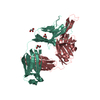
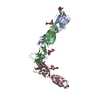

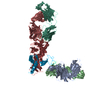
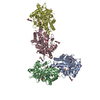




 PDBj
PDBj













